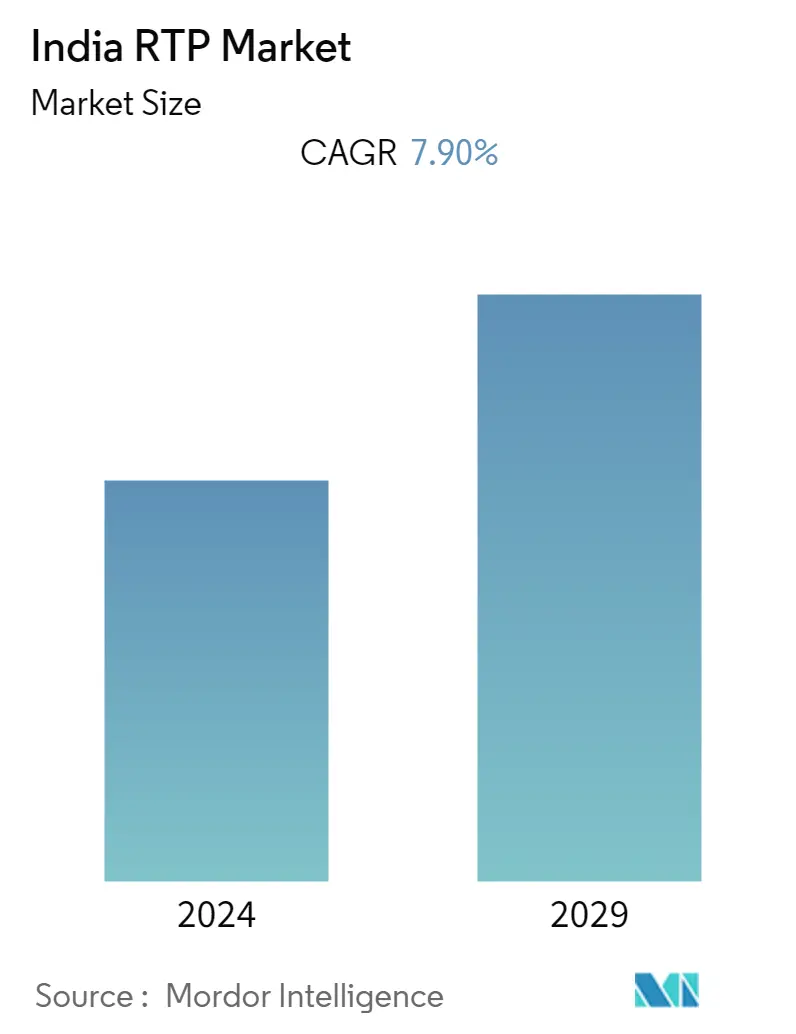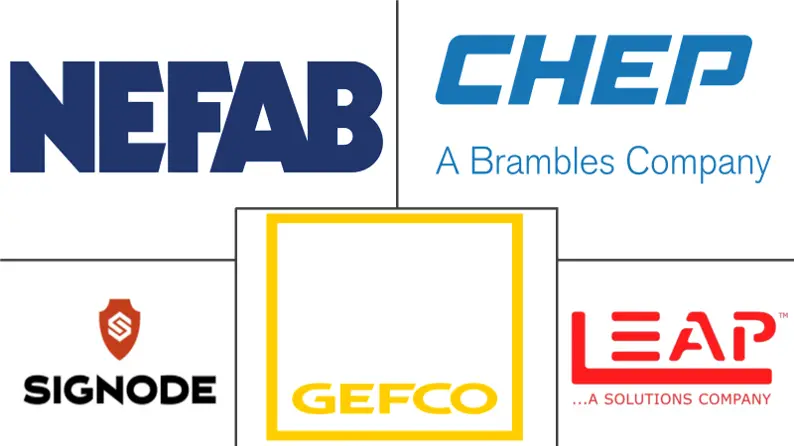Market Size of India RTP Industry

| Study Period | 2019 - 2029 |
| Base Year For Estimation | 2023 |
| Forecast Data Period | 2024 - 2029 |
| Historical Data Period | 2019 - 2022 |
| CAGR | 7.90 % |
| Market Concentration | Medium |
Major Players
*Disclaimer: Major Players sorted in no particular order |
India Returnable Transport Packaging Market Analysis
The India returnable transport packaging (RTP) market was valued at USD 628 million in 2020, and it is expected to reach a value of USD 994.3 million by 2026, registering a CAGR of 7.9% over the forecast period 2021 to 2026. The growing packaging material and supply-chain costs, government regulations, and environmental pressures are anticipated to make returnable transport packaging an attractive and profitable option in the region over the forecast period.
- The packaging industry is situated among the high-growing sectors in India and developing at a rate of 22% to 25% per annum, according to the Packaging Industry Association of India (PIAI). According to a study by trade and commerce trade association, ASSOCHAM, the packaging industry in India is anticipated to reach USD 73.6 billion by FY 2020, resulting in its growing population and income levels.
- The rising cost of packaging, damage to goods in transit, availability of packaging material, and loss of disposing of the packaging material has now brought the attention of companies to sustainable packaging. Hence, businesses realize the importance of having a lasting and low-cost packaging system in place. With the growing demand for consumer goods, which includes even consumer electronics and home appliances, many companies have invested in the Indian retail space in the past few years, driving the retail sector with significant growth across various industries.
- Additionally, the rise of the Indian middle class, the growth of organized retail in the country, rapid growth in exports, and India's e-commerce boom fuel the packaging industry's growth. Thus, the adoption of better packaging methods, materials, and machinery which ensures quality has become very essential for Indian businesses.
- Retailers, especially from the United States and Europe, have been showing interest constantly in the Indian market due to the vast amount of growth opportunities in this sector. This is highlighted by the fact that over 40 major international brands have entered the country over the last two years. Returnable packaging is constantly improving the way that businesses carry out the shipment of their products around in the region. Instead of one-way packaging that is used once and then thrown out, returnable packaging is reused, eliminating the recurring costs of packaging production.
- COVID-19 has impacted the economy with high transaction costs and uncertainty in India's transformed food supply chains. It puts food security at risk as 92% of food consumption in India is purchased, predominantly from the private sector. The government of India is facing the challenge of gathering resources between mitigating the impending food crisis and containing the contagion as the risk of sociopolitical tensions looms large. Amidst all these, the Returnable Transport Packaging Market was also affected significantly during April and May 2020 due to imposed lockdown and restrictions in India.
India Returnable Transport Packaging Industry Segmentation
Returnable Transport Packaging (RTP) is a system of reusable racks, pallets, hand-held containers, or bulk containers that move products safely and efficiently throughout the supply chain. These packaging systems are constructed using durable materials like wood, plastic, and metal. Unlike one-way packaging, they are intended for multiple uses across various end-user industries, including Automotive, Food, and Beverages, Consumer Goods., Electronics and Appliances.
| Material | |
| Plastic | |
| Metal | |
| Wood |
| End-user Industry | |
| Automotive | |
| Food and Beverage | |
| Consumer Goods | |
| Electronics and Appliances | |
| Other End-user Industries |
India RTP Market Size Summary
The India returnable transport packaging (RTP) market is poised for significant growth, driven by increasing packaging material costs, supply chain expenses, and environmental concerns. As businesses seek sustainable and cost-effective packaging solutions, RTP has emerged as a viable option, offering the advantage of reuse over single-use packaging. The Indian packaging industry, a rapidly expanding sector, is fueled by rising consumer demand, the growth of organized retail, and the booming e-commerce market. This growth is further supported by the expanding middle class and increased foreign investment, particularly from retailers in the United States and Europe, who are keen to tap into the vast opportunities within the Indian market. The automotive and food sectors, both critical to India's economy, are also contributing to the RTP market's expansion by adopting eco-friendly packaging solutions to enhance supply chain efficiency and reduce waste.
Despite the challenges posed by the COVID-19 pandemic, which impacted various sectors and disrupted supply chains, the RTP market has shown resilience. The automotive industry, a significant consumer of RTP, is recovering from the downturn, with a focus on streamlining operations and adopting sustainable practices. Similarly, the food and beverage industry is witnessing a shift towards alternative packaging solutions, driven by changing consumer preferences and regulatory pressures to reduce plastic usage. The competitive landscape of the RTP market in India is characterized by the presence of both small and large players, with major companies like Signode Limited, Nefab AB, CHEP Logistics, and LEAP India leading the charge through strategic partnerships and acquisitions. These developments underscore the market's potential for growth and innovation, as businesses increasingly prioritize sustainability and efficiency in their packaging solutions.
India RTP Market Size - Table of Contents
-
1. MARKET DYNAMICS
-
1.1 Market Overview
-
1.2 Industry Attractiveness - Porter's Five Force Analysis
-
1.2.1 Bargaining Power of Suppliers
-
1.2.2 Bargaining Power of Consumers
-
1.2.3 Threat of New Entrants
-
1.2.4 Threat of Substitutes
-
1.2.5 Intensity of Competitive Rivalry
-
-
1.3 Industry Value Chain Analysis
-
-
2. MARKET SEGMENTATION
-
2.1 Material
-
2.1.1 Plastic
-
2.1.2 Metal
-
2.1.3 Wood
-
-
2.2 End-user Industry
-
2.2.1 Automotive
-
2.2.2 Food and Beverage
-
2.2.3 Consumer Goods
-
2.2.4 Electronics and Appliances
-
2.2.5 Other End-user Industries
-
-
India RTP Market Size FAQs
What is the current India RTP Market size?
The India RTP Market is projected to register a CAGR of 7.90% during the forecast period (2024-2029)
Who are the key players in India RTP Market?
GEFCO Group, Nefab AB, Signode Limited, CHEP Logistics and LEAP India are the major companies operating in the India RTP Market.

